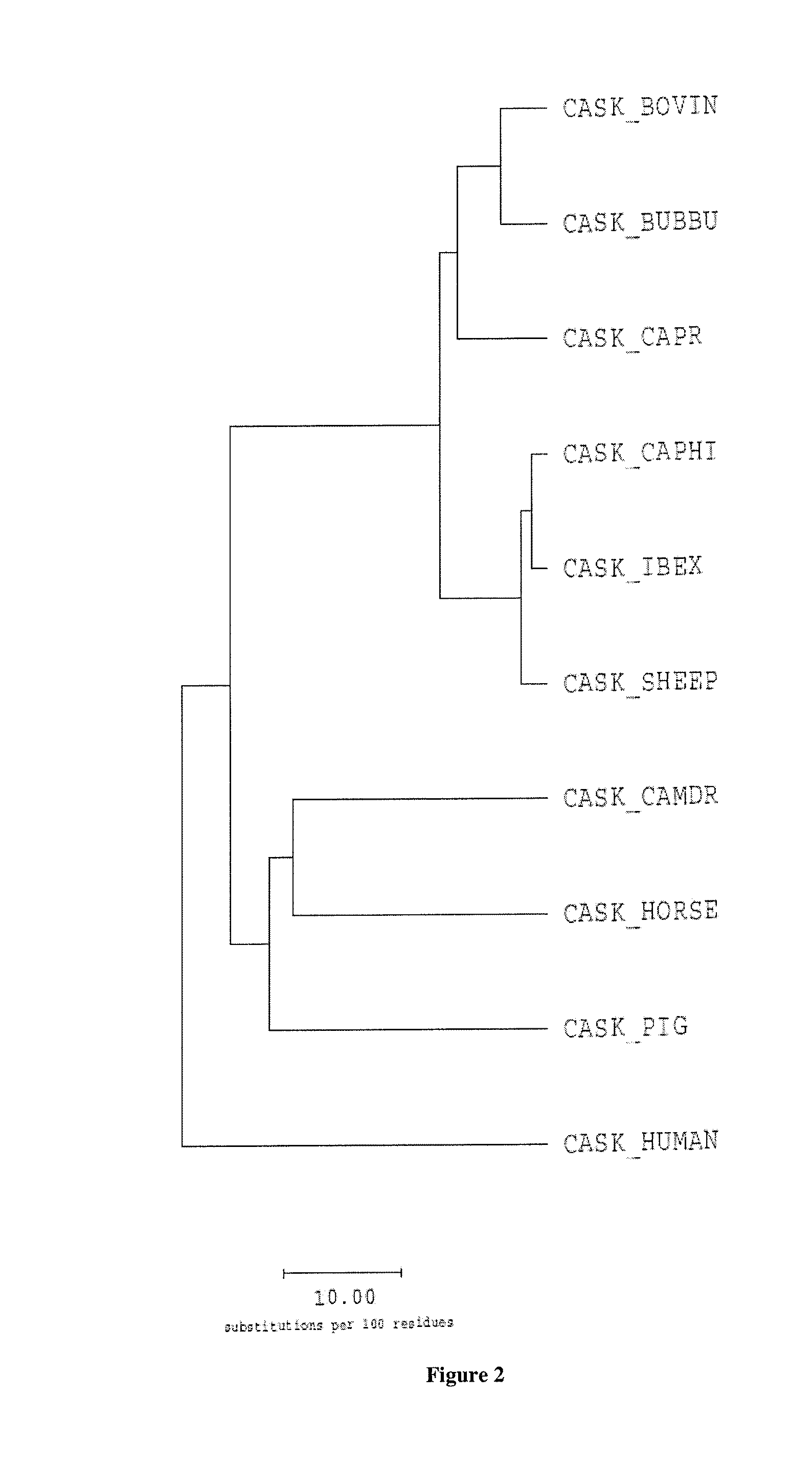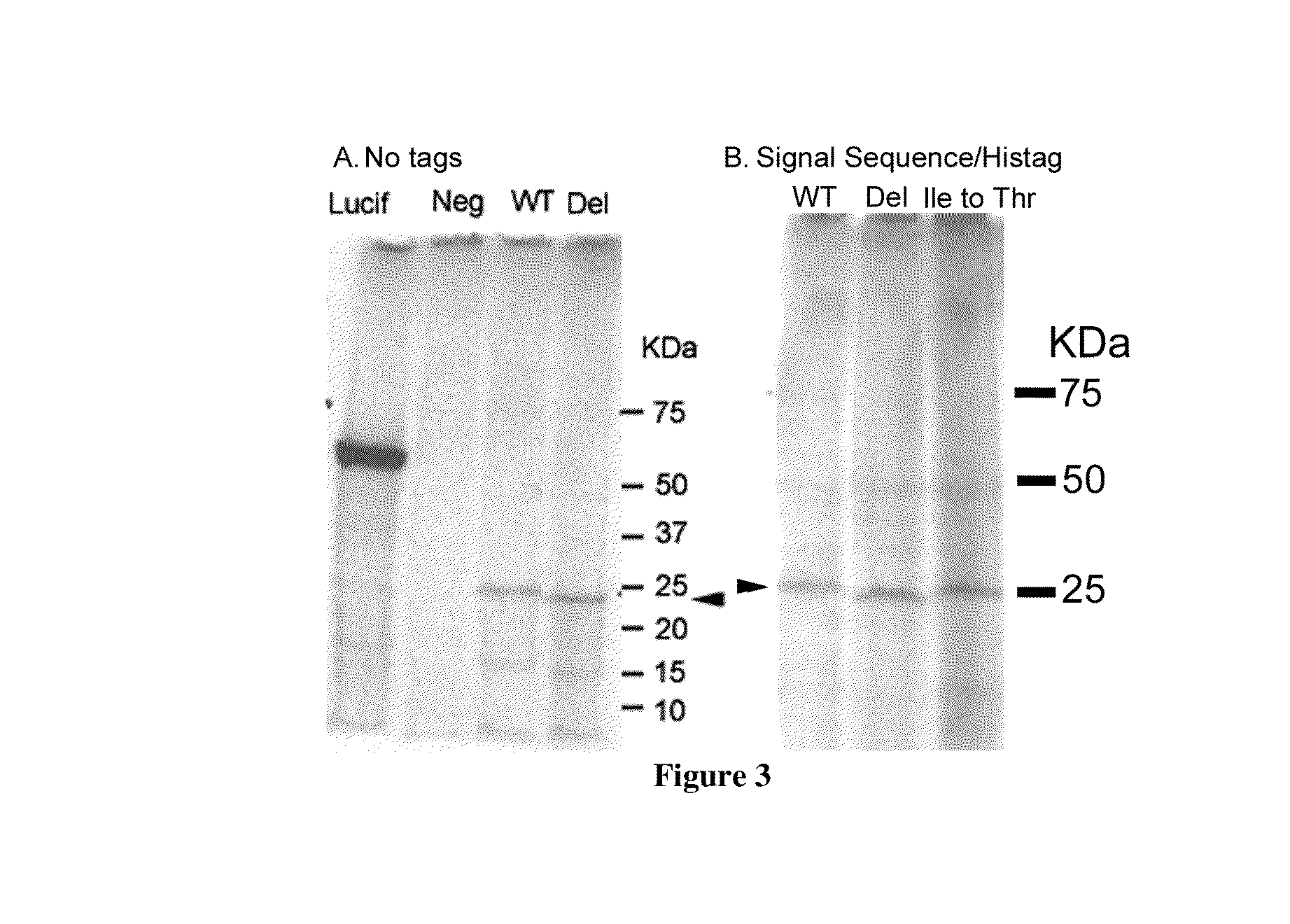Casein and methods of use thereof
a casein and kosher technology, applied in the field of altered kosher kappa casein, can solve the problems of impractical commercial exploitation, and achieve the effect of reducing the allergenicity of a kosher casein polypeptide and reducing the allergenicity of a casein polypeptid
- Summary
- Abstract
- Description
- Claims
- Application Information
AI Technical Summary
Benefits of technology
Problems solved by technology
Method used
Image
Examples
example 1
Reactivity to a “Kosher” Epitope
[0166]A total of 24 patients with known cow's milk allergy and a positive SPT to cow's milk protein were tested for cross-sensitization to milk proteins derived from deer, ibex, buffalo, pig and camel. The clinical characteristics of the twenty four subjects are listed in Table 1. Thirteen of the patients studied were male and eleven were female. Nineteen out of twenty four of the patients (79%) developed a rash after the ingestion of cow's milk, either as the sole symptom (n=2) or as part of a constellation of symptoms as listed in Table 1. With the exception of one patient (p#6), the time from ingestion to the onset of their clinical manifestations was less than twenty minutes. For patient #6, 120 minutes elapsed until clinical symptoms appeared. Eight out of 24 patients (33%) developed anaphylaxis. Six developed generalized edema and in one patient the edema was restricted to the ear. Sixteen out of 24 patients (67%) vomited as part of their clinic...
example 2
Cloning and Sequencing of CDNA Encoding Altered Kosher Kappa Casein
[0175]Construction of the expression systems of the invention, and the molecular biological characterization of it, employs standard methods generally known in the art of recombinant DNA.
[0176]cDNA of Kosher Kappa casein is prepared by methods known to one of skill in the art. Various isoforms of altered cDNA sequences of Kosher Kappa casein such as but not limited to the isoforms encoded by SEQ ID No: 4, 5, 7, 8, 10, 11, 13, and 14 are prepared by methods known to one of skill in the art.
[0177]The library of the isoforms of altered cDNA sequences of Kosher Kappa casein is screened by immunological methods using the kappa casein polyclonal antibodies.
[0178]The procedure used is as follows: E. coli Y1090 bacteria are grown on LA plates containing 50 μg / ml of carbenicillin. A single colony is isolated and grown over night in a LB containing 0.2% maltose and 10 mM MgSO4. 0.4 ml of the culture is then mixed with diluted ...
example 3
Assessing Reactivity of Mutated Bovine K-Casein
The Sequences
[0181]The following optimized Bovine κ-casein sequences were cloned into pYes2, including 5′ BamH1 restriction site followed by AAAA Kozak sequence and 3′EcoR1 site.
A=Wildtype (WT)
[0182]
(SEQ ID No: 15)GGTACCGGATCCAAAAATGATGAAGTCTTTCTTCTTGGTTGTTACTATTTTGGCTTTGACTTTGCCATTTTTGGGTGCTCAAGAACAAAATCAAGAACAACCTATTAGATGTGAAAAGGACGAAAGATTCTTCTCAGATAAGATTGCTAAGTACATTCCAATTCAATACGTTTTGTCTAGATATCCATCTTATGGTTTGAATTACTACCAACAAAAACCAGTTGCTTTGATTAACAATCAATTCTTGCCATATCCATATTATGCTAAACCAGCTGCTGTTAGATCTCCAGCTCAAATTTTACAATGGCAAGTTTTGTCTAATACTGTTCCAGCTAAATCTTGTCAAGCTCAACCTACTACTATGGCTAGACATCCACATCCACATTTGTCTTTTATGGCTATTCCACCAAAAAAAAATCAAGATAAGACTGAAATTCCAACTATTAACACTATTGCTTCAGGTGAACCTACTTCTACTCCAACTACTGAAGCTGTTGAATCTACTGTTGCTACTTTGGAAGATTCTCCAGAAGTTATTGAATCTCCACCAGAAATCAATACTGTTCAAGTTACTTCTACTGCTGTTCATCATCACCATCATCACTAATAAGAATTCGAGCTC.
B=Bovine κ-Casein Positive Control Mutation. Isoleucine at Position 94 Converted to Threonine (Ile—94_Thr)
(SEQ ID...
PUM
| Property | Measurement | Unit |
|---|---|---|
| Fraction | aaaaa | aaaaa |
| Fraction | aaaaa | aaaaa |
| Time | aaaaa | aaaaa |
Abstract
Description
Claims
Application Information
 Login to View More
Login to View More - R&D
- Intellectual Property
- Life Sciences
- Materials
- Tech Scout
- Unparalleled Data Quality
- Higher Quality Content
- 60% Fewer Hallucinations
Browse by: Latest US Patents, China's latest patents, Technical Efficacy Thesaurus, Application Domain, Technology Topic, Popular Technical Reports.
© 2025 PatSnap. All rights reserved.Legal|Privacy policy|Modern Slavery Act Transparency Statement|Sitemap|About US| Contact US: help@patsnap.com



